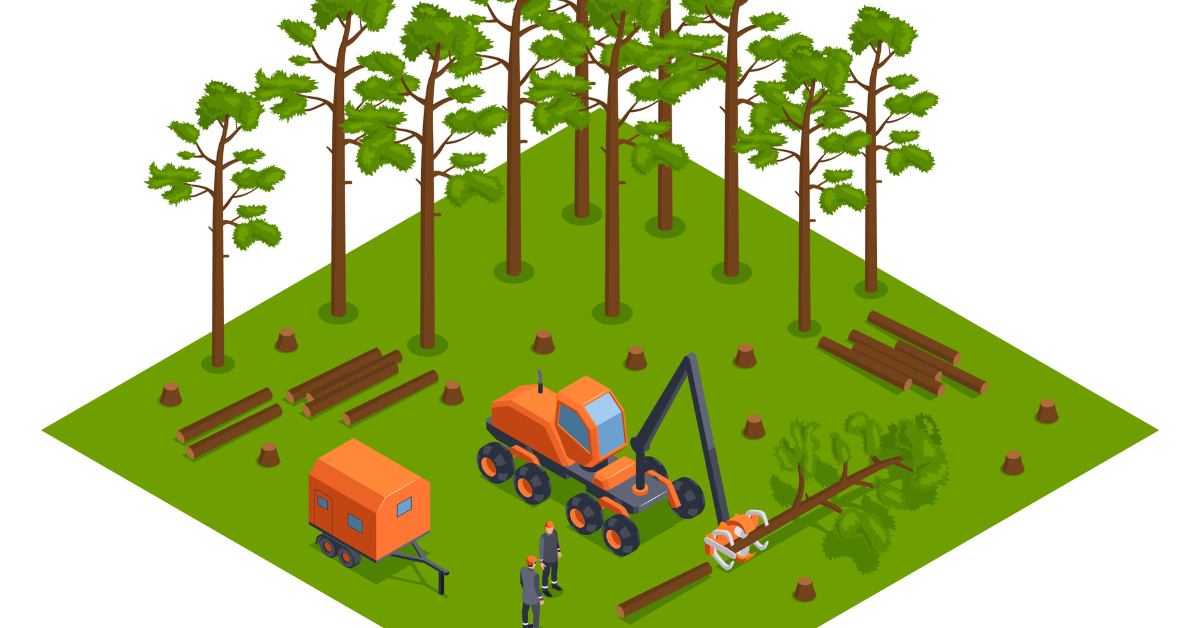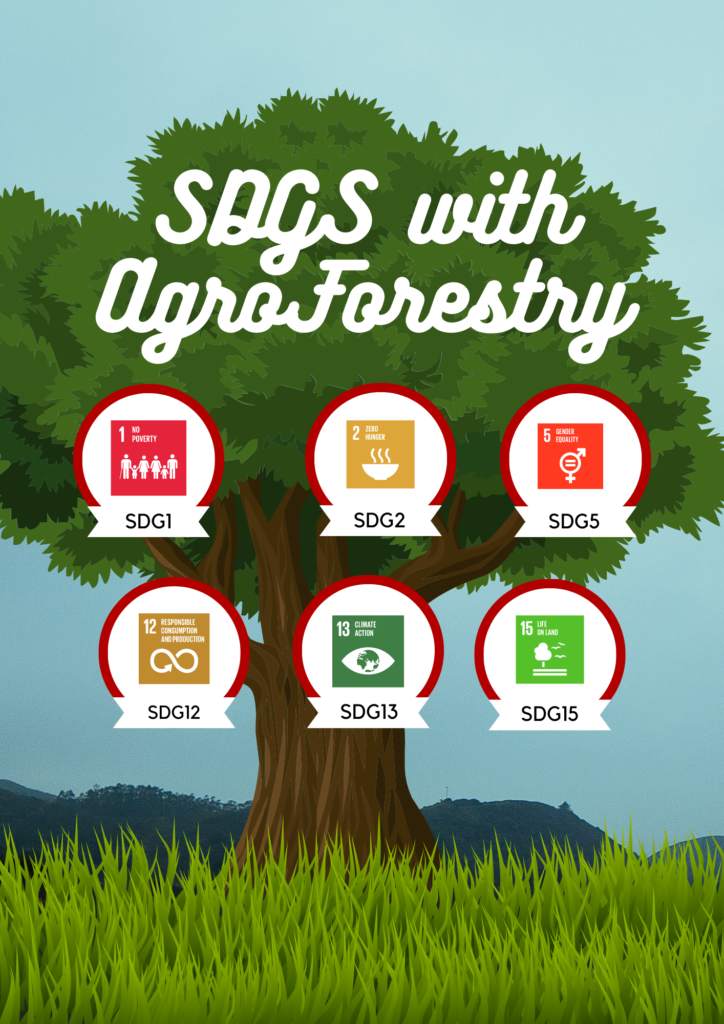Contact: +91 99725 24322 |
Menu
Menu
Quick summary: Explore the remarkable advantages of agroforestry as we delve into its four key benefits: enhanced biodiversity, improved soil health, diversified income streams, and increased agricultural productivity. Discover how this innovative approach transforms landscapes while promoting sustainability and prosperity.

In a world increasingly focused on sustainable practices, agroforestry emerges as a very important aspect of sustainable land management practice. Seamlessly blending agriculture and forestry, agroforestry offers a holistic approach that yields not only economic benefits but also environmental and social advantage.
The shift from agriculture to agroforestry can increase soil organic carbon by 34% on an average, while the conversion from grassland to agroforestry can increase the soil organic carbon by 10%.
From bolstering soil health to mitigating climate change, agroforestry presents a compelling case for redefining the way we cultivate and interact with our landscapes. Join us as we explore the four key benefits that make agroforestry a transformative practice with the potential to shape a more resilient and harmonious future.
Agroforestry is a land management system that has trees and shrubs thriving alongside crops and livestock within a system. It is seen as a more sustainable approach to manage lands where trees, plants and animals co-exist in an ecosystem similar to natural landscapes. It restores the ecological balance in farmlands, prevents soil erosion, water run-off and helps farmers to realize alternate income options and mitigates climate changes.
Agroforestry is a combination of traditional and modern use of land where the trees, crops and animals are holistically managed
The objective of agroforestry is to increase crop production as much as possible while maintaining the local biodiversity of that region. This could result in sustainable use of that land for plantation of crops and trees Carbon offsetting with agroforestry has the potential to provide a financial incentive to sequester carbon using this land management strategy and creating a financial diversification and security to the farmer. The people who follow these agroforestry practices are smallholder farmers and carbon offsetting can have a significant social impact for these impoverished communities.
Agroforestry merges agriculture and forestry offering a nature-based solution that enhances biodiversity, improves soil health and promotes sustainable land management practices.
Agroforestry is the interaction of agriculture and trees which includes the agriculture use of trees. This encompasses trees on farms, farming in forests and tree-crop production including cocoa, coffee, rubber and palm oil. The interactions could be different like trees and crops grown in fields, trees may provide fodder for livestock, fuel, or income from timber on farms and the landscapes where both forestry and agriculture are combined.
The forestry elements can be accommodated in certain ways to cater to the needs of the land.
The trees and crops are integrated into the agricultural land. Crops are intercropped between trees. Farmers should give wider spacing for their crops to achieve the best yield, whereby they get the best nourishment possible.
Trees and shrubs are used to grow pasture. They are primarily grown for fodder for livestock and can also improve the quality of soil. It is essentially the integration of trees with a livestock grazing system.
Agrosilvopastoral systems combine annuals with woody perennials. They could be hedgerows, home gardens and riparian buffers. In hedgerows, trees or shrubs are planted around the agriculture land to form a protective fence. Home gardens are a combination of trees and food production close to homes. Riparian buffer strips involve planting trees or shrubs around water bodies like ponds or streams.
This involves growing and protecting high value speciality crops under the forest canopy adjusting to the correct shade level the crops prefer. The forest is thinned to leave the best canopy trees for continued timber production. The non-timber forest products grown provide an additional source of income and also conserves wildlife habitat.
Trees and plants differ in their requirements and with the sharing of resources, agroforestry systems can promote mutual benefits.

Agroforestry nurtures soil health through a combination of planting techniques and relationships among trees, crops and other vegetation.
Trees and shrubs in agroforestry systems act as natural windbreaks and barriers, preventing soil erosion caused by water runoff. Their root systems also help bind the soils, reducing compaction and enhancing its structure.
Agroforestry incorporates nitrogen fixing plants like leguminous trees and cover crops which enrich the soil with nitrogen. This increases soil fertility by providing essential nutrients.
Fallen leaves, branches and the organic debris from trees contribute to increased organic matter content in the soil. This organic content improves soil structure, water retention and nutrient availability for microorganisms to thrive.
Agroforestry diverses the landscape attracting a range of beneficial birds and insects which help control pest populations, thereby reducing the need for chemical interventions that can harm soil health.
Trees in agroforestry systems capture carbon dioxide from the atmosphere, contributing to long term carbon sequestration.
Trees and crops facilitate nutrient cycling by interacting with each other.
Agroforestry is a powerful tool for enhancing biodiversity by creating diverse and interconnected ecosystems that support a wide range of plant and animal species.
Agroforestry systems incorporate various layers of vegetation from trees, shrubs to groundcover plants thereby providing habitat for multitude of species, including insects, birds and microorganisms.
A diverse ecosystem in agroforestry can include predators of pests. These systems can help maintain predator-prey relationships, reducing the need for chemical pest control
Trees and flowering plants within agroforestry systems provide food and shelter for pollinators like bees, butterflies and birds. This boosts pollination of both crops and wild plants, ensuring reproductive success.
Agroforestry fosters a healthy soil ecosystem that increases microbial diversity. These organisms enhance nutrient cycling, decomposition and disease suppression, contributing to the ecosystem health.
By incorporating a mix of plant species , agroforestry conserves genetic diversity within the cultivated species. This helps plants to adapt to changing environment and resist diseases.
Agroforestry has the ability to enhance agriculture productivity through harmonious integration of trees, crops and other vegetation.
Trees in agroforestry contribute organic matter that enriches the soil, boosting nutrient availability and promoting healthy plant growth.
Tree roots prevent soil erosion and compaction allowing plants to access nutrients and water supporting higher yields.
Trees provide shading and windbreaks creating microclimates that protect crops from weather extremities. This enables crop cultivation and extends growing seasons.
Agroforestry controls pest outbreaks thereby causing less damage to crops, contributing to higher yields.
Trees and flowering plants attract pollinators thereby resulting in higher fruit and seed production, resulting in increased yields.
The cultivation of shade tolerant crops increases land use efficiency and maximizes productivity.
Agroforestry offers farmers a diversified income portfolio by incorporating a mix of tree species, crops and other vegetation within a single landscape.
Agroforestry systems yield a variety of products such as timber, fruits, nuts, medicinal plants and fodder. These products can be sold in various markets, adding to the income.
The world today is looking into investing in ancient systems of agroforestry to create sustainable solutions for the environment. This could provide better access to nutritional and food security and better livelihoods of millions of farmers.
Some agroforestry practices qualify for carbon offset programs. Farmers can generate additional income by selling carbon credits based on the carbon sequestration potential of their agroforestry systems.
Agroforestry incorporates forage crops and fodder trees providing supplement feed for livestock through which income can be generated.
Agroforestry provides a holistic management of crops, trees, plants and livestock to form a self-sustaining production system. It improves the resilience of food production against the impacts of climate change. Healthy soils form the basis of our food supply chains. The plant diversity boosts soil fertility by preventing soil erosion, regulates water cycles, controls pests and diseases and sequesters carbon. Increasing agriculture productivity can improve the efficiency of land use and help in protecting biodiversity.
Agroforestry is a low hanging fruit for achieving SDGs.

SDG1 – Integrating trees with agriculture increases income and production by reducing costs of inputs and production.
SDG2 – Agroforestry provides food and increased incomes, almost a lifeline to the poor people.
SDG5 – Growing trees nearby gives easy access to firewood which is beneficial for the women who can get more productive elsewhere.
SDG12 – The production of agriculture commodities without depleting the natural resources and minimal use of chemicals and pesticides helps in sustainable production.
SDG13 – The potential to sequester carbon helps to combat climate change.
SDG15 – Agroforestry contributes to conservation of flora and fauna and preserves land ecosystems.
TraceX is working towards mitigating climate change with technology driven nature based solutions.
Technology Solutions from TraceX
TraceX is working towards mitigating climate change with technology driven nature based solutions.
TraceX technology solutions are revolutionizing agroforestry by merging cutting edge technology with sustainable land management practices. BY empowering farmers with insights, tools and platforms, TraceX is driving adoption of agroforestry systems that enhance productivity, foster biodiversity and promote environmentally sound agriculture practices.
The Trace Carbon module drives integrity and credibility into the measurement, reporting and verification of carbon offsets generated through carbon activities like regenerative agriculture, rice cultivation and agroforestry.
Agroforestry focuses on balancing the preservation of natural forests with productive agriculture. Amidst deforestation threats, sustainable agroforestry offers a powerful medium to sustain feeding communities and protecting the environment from further degradation. Agroforestry is a model of sustainable land use where communities are empowered to generate income from crops while keeping forests healthy and sound.
